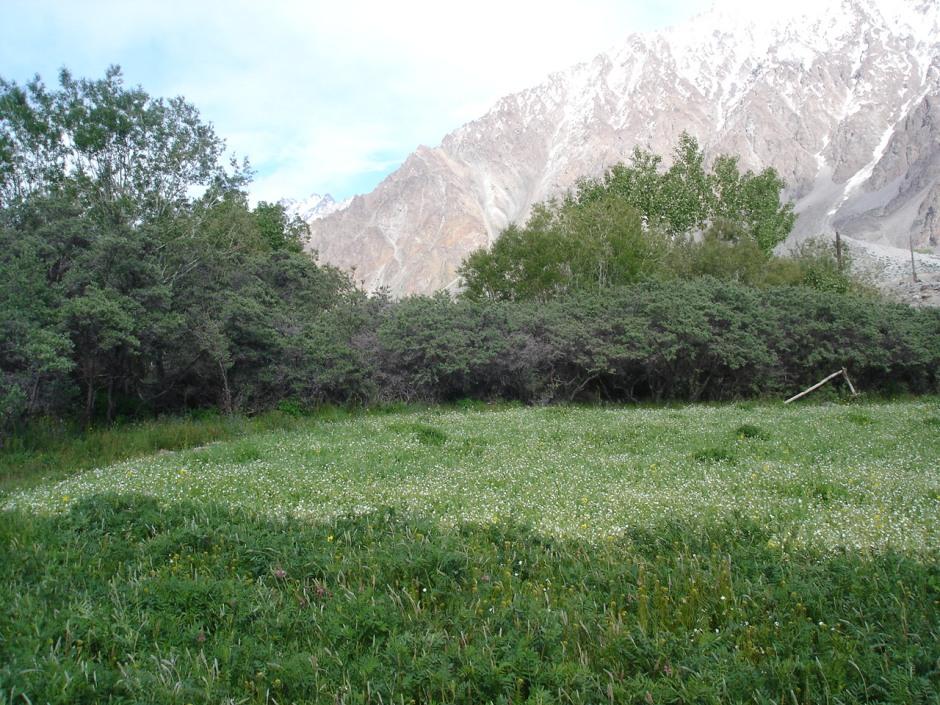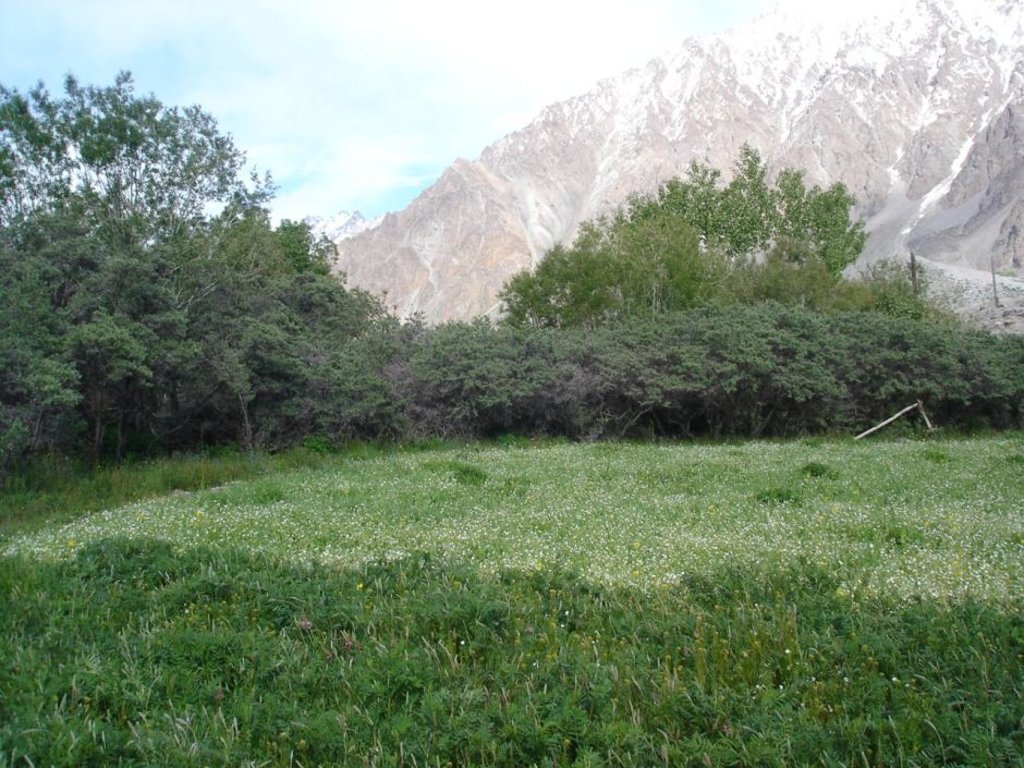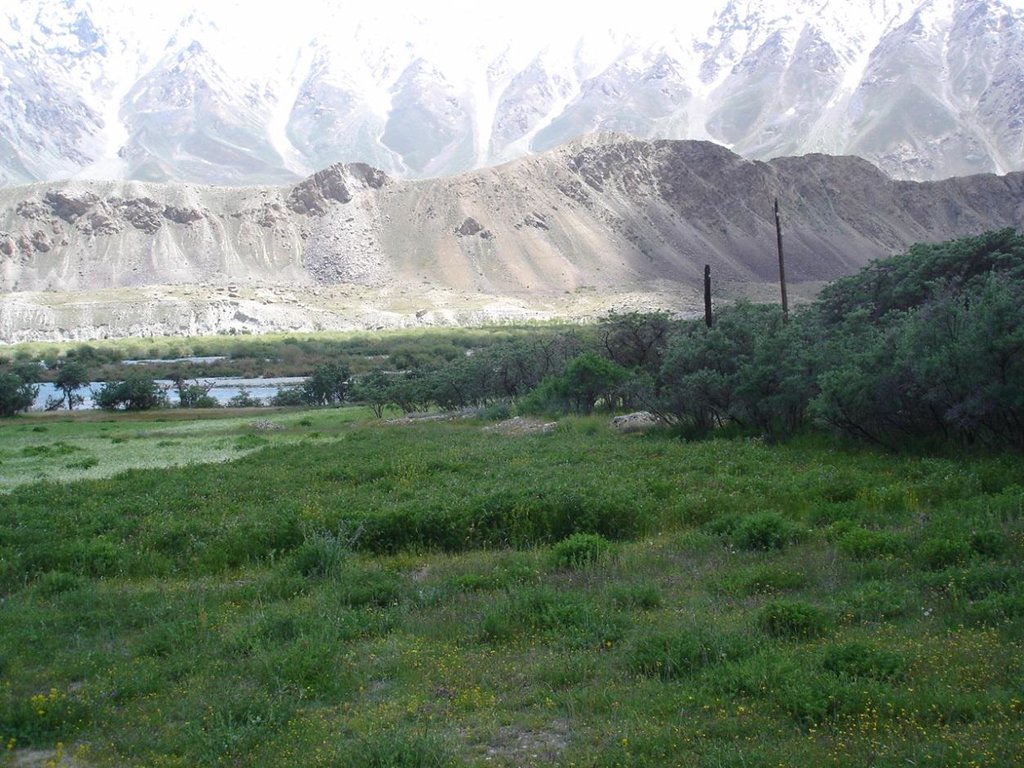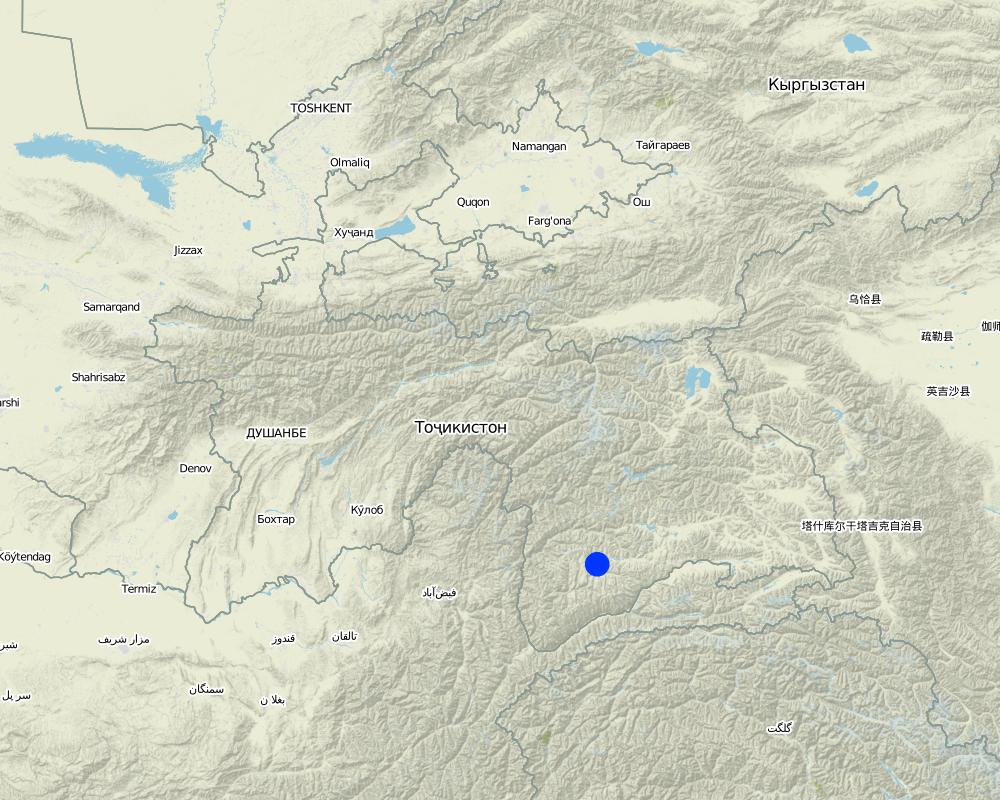Agroforestry in arid alpine zone above 3300 m asl [Tajikistan]
- Creation:
- Update:
- Compiler: Gulniso Nekushoeva
- Editor: –
- Reviewers: David Streiff, Alexandra Gavilano
technologies_1056 - Tajikistan
View sections
Expand all Collapse all1. General information
1.2 Contact details of resource persons and institutions involved in the assessment and documentation of the Technology
SLM specialist:
Name of the institution(s) which facilitated the documentation/ evaluation of the Technology (if relevant)
Tajik Soil Insitute (Tajik Soil Institute) - TajikistanName of the institution(s) which facilitated the documentation/ evaluation of the Technology (if relevant)
Tajik Academy of Agricultural Sciences (Tajik Academy of Agricultural Sciences) - Tajikistan1.3 Conditions regarding the use of data documented through WOCAT
The compiler and key resource person(s) accept the conditions regarding the use of data documented through WOCAT:
Ja
2. Description of the SLM Technology
2.1 Short description of the Technology
Definition of the Technology:
Cultivation of grain, potatoes and forage crops (esparzet) under the protection of windbreak live fence in the zone of risky agriculture (in the arid highlands traditional livestock zone of the Pamirs) above 3300m a.s.l
2.2 Detailed description of the Technology
Description:
Purpose of the Technology: Increase the possibility of subsistence grain, potatoes and fodder. Reduce the dependence of yield of sharp daily fluctuations of temperature, cold winds and frost
2.3 Photos of the Technology
2.5 Country/ region/ locations where the Technology has been applied and which are covered by this assessment
Country:
Tajikistan
Region/ State/ Province:
Tajikistan/ GBAO
Further specification of location:
Shugnan/ Vankala, v.Bachor
Specify the spread of the Technology:
- evenly spread over an area
If precise area is not known, indicate approximate area covered:
- < 0.1 km2 (10 ha)
Comments:
Total area covered by the SLM Technology is 0.015 km2.
farmer's land is composed of several disparate fields, rather than one large area
Map
×2.6 Date of implementation
If precise year is not known, indicate approximate date:
- less than 10 years ago (recently)
2.7 Introduction of the Technology
Specify how the Technology was introduced:
- through land users' innovation
Comments (type of project, etc.):
sowing of cereals and potatoes in a frame of trees had started 18 years ago, and sowing esparzet on third part of their land began in 2008, seeing in the center of Jamoat Vankala esparzet that have been produced through MSDSP, swapped seeds and planted
3. Classification of the SLM Technology
3.1 Main purpose(s) of the Technology
- improve production
3.2 Current land use type(s) where the Technology is applied
Land use mixed within the same land unit:
Ja
Specify mixed land use (crops/ grazing/ trees):
- Agroforestry

Cropland
- Annual cropping
- Perennial (non-woody) cropping
- Tree and shrub cropping
- sea buckthorn
Number of growing seasons per year:
- 1
Specify:
Longest growing period in days: 90Longest growing period from month to month: June-August
Comments:
Major land use problems (compiler’s opinion): low natural fertility of the stony shallow soils, short growing season, the zone of risky agriculture, farming is not possible without irrigation, despite the low temperatures
Major land use problems (land users’ perception): low temperatures at night in growing period , often leading to freezing of potato and grain maturation ..
Future (final) land use (after implementation of SLM Technology): Mixed: Mf: Agroforestry
3.3 Has land use changed due to the implementation of the Technology?

Grazing land
Comments:
Grazing land: Ge: Extensive grazing land
3.4 Water supply
Water supply for the land on which the Technology is applied:
- full irrigation
3.5 SLM group to which the Technology belongs
- agroforestry
- windbreak/ shelterbelt
3.6 SLM measures comprising the Technology

agronomic measures
- A1: Vegetation/ soil cover

vegetative measures
- V1: Tree and shrub cover

structural measures
- S3: Graded ditches, channels, waterways

management measures
- M1: Change of land use type
Comments:
Main measures: agronomic measures, vegetative measures, structural measures, management measures
Type of agronomic measures: better crop cover, cover cropping, manure / compost / residues, furrows (drainage, irrigation)
Type of vegetative measures: aligned: -against wind, aligned: -along boundary
3.7 Main types of land degradation addressed by the Technology

chemical soil deterioration
- Cn: fertility decline and reduced organic matter content (not caused by erosion)

biological degradation
- Bc: reduction of vegetation cover
- Bq: quantity/ biomass decline

water degradation
- Ha: aridification
Comments:
Main type of degradation addressed: Bc: reduction of vegetation cover, Bq: quantity / biomass decline
Secondary types of degradation addressed: Cn: fertility decline and reduced organic matter content, Ha: aridification
Main causes of degradation: deforestation / removal of natural vegetation (incl. forest fires) (lack of electricity and a long winter forced people to cut most of trees), over-exploitation of vegetation for domestic use (food unsecurity), overgrazing (because of the inability to sent livestock to remote pastures in Murgab), change in temperature (frequent frosts in the vegetation season lead to the eradication (t° variability)), population pressure (Because of need for subsistence there is intense pressure on arable land), poverty / wealth (Basically, all people are poor)
Secondary causes of degradation: soil management (The need for subsistence from 92th forced people to do farming), droughts (High aridity, minimum precipitation. forced to irrigate), labour availability (work is only in 1-9 classes school and on little ambulatory.), inputs and infrastructure: (roads, markets, distribution of water points, other, …) (complete isolation in winter, bad roads, no access to the market), education, access to knowledge and support services (There is a school until 9 class), war and conflicts (after the crisis of the 90s and the civil war forced to subsistence)
3.8 Prevention, reduction, or restoration of land degradation
Specify the goal of the Technology with regard to land degradation:
- reduce land degradation
Comments:
Secondary goals: prevention of land degradation, rehabilitation / reclamation of denuded land
4. Technical specifications, implementation activities, inputs, and costs
4.1 Technical drawing of the Technology
Technical specifications (related to technical drawing):
echnical knowledge required for land users: moderate
Main technical functions: improvement of ground cover, improvement of surface structure (crusting, sealing), increase in organic matter, increase in nutrient availability (supply, recycling,…), reduction in wind speed, increase of biomass (quantity)
Secondary technical functions: increase of surface roughness, improvement of topsoil structure (compaction), stabilisation of soil (eg by tree roots against land slides), increase / maintain water stored in soil, water harvesting / increase water supply, promotion of vegetation species and varieties (quality, eg palatable fodder), spatial arrangement and diversification of land use
Better crop cover
Material/ species: barley
Quantity/ density: 200kg/ha
Manure / compost / residues
Material/ species: manure
Quantity/ density: 4t/ha
Furrows (drainage, irrigation)
Material/ species: irrigation canals net
Quantity/ density: 200/ha
Aligned: -against wind
Vegetative material: T : trees / shrubs
Spacing between rows / strips / blocks (m): 1
Vertical interval within rows / strips / blocks (m): 1
Aligned: -along boundary
Vegetative material: T : trees / shrubs
Waterway
Material: Earth
Trees/ shrubs species: T- sea buckthorn, in the begining - planted
Perennial crops species: C-esparzet on 1\3 of the field
Slope (which determines the spacing indicated above): 5-8%
Author:
Gulniso Nekushoeva, Dushanbe, Tajikistan
4.2 General information regarding the calculation of inputs and costs
other/ national currency (specify):
Somoni
If relevant, indicate exchange rate from USD to local currency (e.g. 1 USD = 79.9 Brazilian Real): 1 USD =:
4.52
Indicate average wage cost of hired labour per day:
30
4.3 Establishment activities
| Activity | Timing (season) | |
|---|---|---|
| 1. | Clean up the plot of the stones and shrubs | |
| 2. | plowing | |
| 3. | manuring | |
| 4. | Sowing of barley, rye | |
| 5. | Planting potatoes | |
| 6. | preparing sea-buckthorn seedlings | spring |
| 7. | bringing and putting manure in the holes | end of spring |
| 8. | manure | |
| 9. | planting seedlings along the irrigation canal | planting seedlings along the irrigation canal |
| 10. | irrigation of the seedlings |
4.4 Costs and inputs needed for establishment
| Specify input | Unit | Quantity | Costs per Unit | Total costs per input | % of costs borne by land users | |
|---|---|---|---|---|---|---|
| Labour | Cleaning up the plot | Persons/day | 4.0 | 30.0 | 120.0 | 100.0 |
| Labour | Plowing | Persons/day | 6.0 | 30.0 | 180.0 | 100.0 |
| Labour | Manuring | Persons/day | 7.0 | 30.0 | 210.0 | 100.0 |
| Labour | Preparing sea-buckthorn | Persons/day | 3.0 | 35.0 | 105.0 | 100.0 |
| Plant material | Barley rye seeds | ha | 1.0 | 430.0 | 430.0 | 100.0 |
| Plant material | Potatoe seeds | ha | 1.0 | 110.0 | 110.0 | 100.0 |
| Fertilizers and biocides | Manure | kg | 400.0 | 0.0625 | 25.0 | |
| Other | Labour: Bringing and putting manure in the holes | Persons/day | 2.0 | 35.0 | 70.0 | 100.0 |
| Other | Labour: Planting seedlings along the irrigation cana | Persons/day | 4.0 | 35.0 | 140.0 | 100.0 |
| Other | Labour: Irrigation of the seedlings | Persons/day | 1.0 | 35.0 | 35.0 | 100.0 |
| Total costs for establishment of the Technology | 1425.0 | |||||
| Total costs for establishment of the Technology in USD | 315.27 | |||||
4.5 Maintenance/ recurrent activities
| Activity | Timing/ frequency | |
|---|---|---|
| 1. | irrigation of the crop fields | during growing/ |
| 2. | irrigation of potatoes field | during growing/ |
| 3. | weeding of potatoes field | during growing/2-3time |
| 4. | harvesting potatoes | september/every year |
| 5. | harvesting crops | september/every year |
| 6. | irrigation of bushes | |
| 7. | pruning and cutting the brunches | |
| 8. | mowing the natural grass |
4.6 Costs and inputs needed for maintenance/ recurrent activities (per year)
| Specify input | Unit | Quantity | Costs per Unit | Total costs per input | % of costs borne by land users | |
|---|---|---|---|---|---|---|
| Labour | Weeding / harvesting of potatoes field | Persons/day | 4.0 | 30.0 | 120.0 | 100.0 |
| Labour | Harvesting crops | Persons/day | 6.0 | 30.0 | 180.0 | 100.0 |
| Total costs for maintenance of the Technology | 300.0 | |||||
| Total costs for maintenance of the Technology in USD | 66.37 | |||||
Comments:
Machinery/ tools: shovel, shears,axe
5. Natural and human environment
5.2 Topography
Slopes on average:
- flat (0-2%)
- gentle (3-5%)
- moderate (6-10%)
- rolling (11-15%)
- hilly (16-30%)
- steep (31-60%)
- very steep (>60%)
Landforms:
- plateau/plains
- ridges
- mountain slopes
- hill slopes
- footslopes
- valley floors
Altitudinal zone:
- 0-100 m a.s.l.
- 101-500 m a.s.l.
- 501-1,000 m a.s.l.
- 1,001-1,500 m a.s.l.
- 1,501-2,000 m a.s.l.
- 2,001-2,500 m a.s.l.
- 2,501-3,000 m a.s.l.
- 3,001-4,000 m a.s.l.
- > 4,000 m a.s.l.
Comments and further specifications on topography:
Altitudinal zone: 3300m
5.3 Soils
Soil depth on average:
- very shallow (0-20 cm)
- shallow (21-50 cm)
- moderately deep (51-80 cm)
- deep (81-120 cm)
- very deep (> 120 cm)
If available, attach full soil description or specify the available information, e.g. soil type, soil PH/ acidity, Cation Exchange Capacity, nitrogen, salinity etc.
Soil drainage / infiltration is good
5.4 Water availability and quality
Water quality (untreated):
good drinking water
5.5 Biodiversity
Species diversity:
- medium
5.6 Characteristics of land users applying the Technology
Market orientation of production system:
- subsistence (self-supply)
Relative level of wealth:
- poor
- average
Individuals or groups:
- individual/ household
Level of mechanization:
- manual work
- animal traction
Gender:
- women
- men
Indicate other relevant characteristics of the land users:
Land users applying the Technology are mainly common / average land users
Population density: < 10 persons/km2
5.7 Average area of land used by land users applying the Technology
- < 0.5 ha
- 0.5-1 ha
- 1-2 ha
- 2-5 ha
- 5-15 ha
- 15-50 ha
- 50-100 ha
- 100-500 ha
- 500-1,000 ha
- 1,000-10,000 ha
- > 10,000 ha
Is this considered small-, medium- or large-scale (referring to local context)?
- small-scale
5.8 Land ownership, land use rights, and water use rights
Land ownership:
- state
Land use rights:
- leased
Water use rights:
- open access (unorganized)
5.9 Access to services and infrastructure
health:
- poor
- moderate
- good
education:
- poor
- moderate
- good
technical assistance:
- poor
- moderate
- good
employment (e.g. off-farm):
- poor
- moderate
- good
markets:
- poor
- moderate
- good
energy:
- poor
- moderate
- good
roads and transport:
- poor
- moderate
- good
drinking water and sanitation:
- poor
- moderate
- good
financial services:
- poor
- moderate
- good
6. Impacts and concluding statements
6.1 On-site impacts the Technology has shown
Socio-economic impacts
Production
crop production
fodder production
fodder quality
wood production
risk of production failure
product diversity
production area
energy generation
Income and costs
farm income
diversity of income sources
Socio-cultural impacts
food security/ self-sufficiency
health situation
SLM/ land degradation knowledge
Livelihood and human well-being
Ecological impacts
Water cycle/ runoff
evaporation
Soil
soil moisture
soil cover
soil loss
soil compaction
nutrient cycling/ recharge
soil organic matter/ below ground C
Biodiversity: vegetation, animals
biomass/ above ground C
plant diversity
beneficial species
Climate and disaster risk reduction
emission of carbon and greenhouse gases
wind velocity
6.3 Exposure and sensitivity of the Technology to gradual climate change and climate-related extremes/ disasters (as perceived by land users)
Gradual climate change
Gradual climate change
| Season | increase or decrease | How does the Technology cope with it? | |
|---|---|---|---|
| annual temperature | increase | well |
Climate-related extremes (disasters)
Meteorological disasters
| How does the Technology cope with it? | |
|---|---|
| local windstorm | well |
Other climate-related consequences
Other climate-related consequences
| How does the Technology cope with it? | |
|---|---|
| reduced growing period | not well |
6.4 Cost-benefit analysis
How do the benefits compare with the establishment costs (from land users’ perspective)?
Short-term returns:
slightly positive
Long-term returns:
very positive
How do the benefits compare with the maintenance/ recurrent costs (from land users' perspective)?
Short-term returns:
slightly positive
Long-term returns:
very positive
6.5 Adoption of the Technology
- > 50%
If available, quantify (no. of households and/ or area covered):
1 housefold in an area of 1.5 ha
Of all those who have adopted the Technology, how many did so spontaneously, i.e. without receiving any material incentives/ payments?
- 91-100%
7. References and links
7.1 Methods/ sources of information
Links and modules
Expand all Collapse allLinks
No links
Modules
No modules





